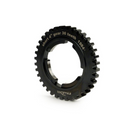BGM PRO Vespa Driveshaft 4th Gear (36 tooth) a PX125-150 (1984-), T5 125cc, Cosa125-150, LML Star/Stella125/150 2-stroke - short 4th gear for PX200 (1984-), Cosa200
BGM Pro gear parts are ultra-solid material. For the highest loads, the gear wheels are made of high-alloy NiCrMo case-hardened steel (20NiCrMo2-2/ AISI8620).
The very good base material withstands even the highest engine power. The precisely defined surface hardening to 58-60HRC makes the pinions extremely resistant to wear. Better than Piaggio goods. Always consistent high quality. No compromises.
BETTER
Suitable for all types of use, whether tourer or racer.
With 36 teeth one tooth shorter than the original 4 gear wheel of a PX200.
The gear connection to the fourth gear is noticeably improved.
FIT
Suitable for all transmissions with a flat shifting cross. These gearboxes can be identified by the main shaft which has a circlip in front of the gears. The middle segment, on which the shifting cross rests, is with
- PX old (until 1984, cranked shifting cross) : 5mm
- Lusso (from 1984, flat shifting cross): 6,5mm
The middle segment of the BGM gearwheels is larger (approx. 1/10mm) and thus offers even more contact surface for the gearshift cross.
TIP: Ideal combination with the longer reduced 64 teeth BGM Pro primary gear. The total gear ratio is significantly longer in conjunction with a 24Z clutch pinion, the gear jump three to four but shorter. This allows the full engine power to be converted into top speed.
NOTE: The fourth gear with 36 teeth was developed by Piaggio for the 125cc models. It was constructed by a so-called tooth flank shift from the 4-speed of the 150/180/200cc models with 35 teeth. By this technique the gearing of the auxiliary shaft could be kept identical for all models. A disadvantage of the 36 tooth gear is however the narrower tooth base. This results when more teeth have to be accommodated on a given diameter. The narrower tooth base is of course not as stable as the 35 tooth gear, which is why Piaggio only used it in the 125cc models.
However, the short 36 Z gear is very popular on performance 200cc engines. With very sporty engine layouts, the jump from gear 3 to gear 4 is too big and the engine can't get into its powerband. With today's very high-torque concepts (like Malossi Sport/MHR or Quattrini M244) this tuning trick from the 1990's is still often used.
We strongly recommend to use a 4 speed with 35 teeth. The high engine torque together with a load peak (gear jumping, shifted etc.) can otherwise damage a 36 tooth gear. If you still need a shorter gear jump, you should realize this with another auxiliary shaft with less teeth (e.g. BGM6505 or BGM6506).
Comparison No. 2232294 (PIAGGIO)
BGM PRO Vespa Driveshaft 4th Gear (36 tooth) a PX125-150 (1984-), T5 125cc, Cosa125-150, LML Star/Stella125/150 2-stroke - short 4th gear for PX200 (1984-), Cosa200
BGM Pro gear parts are ultra-solid material. For the highest loads, the gear wheels are made of high-alloy NiCrMo case-hardened steel (20NiCrMo2-2/ AISI8620).
The very good base material withstands even the highest engine power. The precisely defined surface hardening to 58-60HRC makes the pinions extremely resistant to wear. Better than Piaggio goods. Always consistent high quality. No compromises.
BETTER
Suitable for all types of use, whether tourer or racer.
With 36 teeth one tooth shorter than the original 4 gear wheel of a PX200.
The gear connection to the fourth gear is noticeably improved.
FIT
Suitable for all transmissions with a flat shifting cross. These gearboxes can be identified by the main shaft which has a circlip in front of the gears. The middle segment, on which the shifting cross rests, is with
- PX old (until 1984, cranked shifting cross) : 5mm
- Lusso (from 1984, flat shifting cross): 6,5mm
The middle segment of the BGM gearwheels is larger (approx. 1/10mm) and thus offers even more contact surface for the gearshift cross.
TIP: Ideal combination with the longer reduced 64 teeth BGM Pro primary gear. The total gear ratio is significantly longer in conjunction with a 24Z clutch pinion, the gear jump three to four but shorter. This allows the full engine power to be converted into top speed.
NOTE: The fourth gear with 36 teeth was developed by Piaggio for the 125cc models. It was constructed by a so-called tooth flank shift from the 4-speed of the 150/180/200cc models with 35 teeth. By this technique the gearing of the auxiliary shaft could be kept identical for all models. A disadvantage of the 36 tooth gear is however the narrower tooth base. This results when more teeth have to be accommodated on a given diameter. The narrower tooth base is of course not as stable as the 35 tooth gear, which is why Piaggio only used it in the 125cc models.
However, the short 36 Z gear is very popular on performance 200cc engines. With very sporty engine layouts, the jump from gear 3 to gear 4 is too big and the engine can't get into its powerband. With today's very high-torque concepts (like Malossi Sport/MHR or Quattrini M244) this tuning trick from the 1990's is still often used.
We strongly recommend to use a 4 speed with 35 teeth. The high engine torque together with a load peak (gear jumping, shifted etc.) can otherwise damage a 36 tooth gear. If you still need a shorter gear jump, you should realize this with another auxiliary shaft with less teeth (e.g. BGM6505 or BGM6506).
Comparison No. 2232294 (PIAGGIO)






